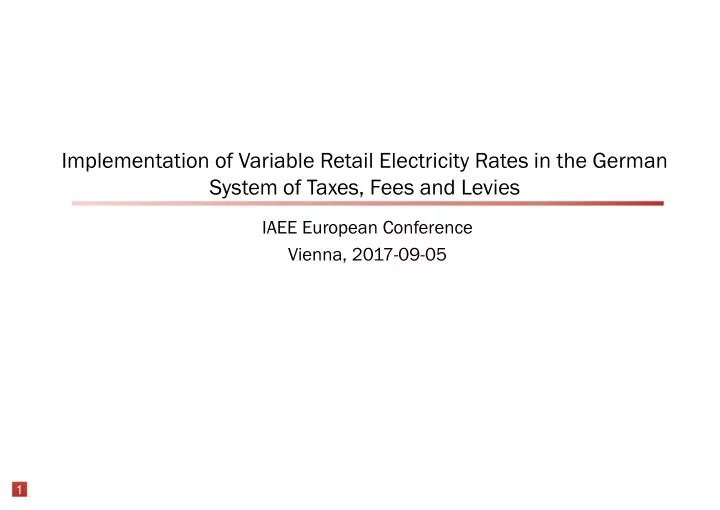

Implementation of Variable Retail Electricity Rates in the German System of Taxes, Fees and Levies IAEE European Conference Vienna, 2017-09-05 1
Outline 1 Motivation: Why might implementing variable rates be a good idea? 2 Retail price components in Germany 3 Current and prospective flexibilization potential 4 Conclusion 2 2
Outline 1 Motivation: Why might implementing variable rates be a good idea? 2 Retail price components in Germany 3 Current and prospective flexibilization potential 4 Conclusion 3 3
Everyone wants variable rates Which rate structures are suitable for residential customers? Can simple time-of-use rates affect the behavior sufficiently? Which goals can be reached with these type of rates? 4 How can this be simulated? 4
Three fundamental elements can be varied based on several influences Base se fee Deman mand d char arge Ener ergy price Price for peak demand in a Price per consumed unit of Fixed amount which has to defined time frame, usually energy, usually measured in be paid per unit of time, measured in kW kWh usually per month or year can an be be depen enden dent on on • Customer group • Customer group • Customer group • Time • Time • Energy consumption • Energy consumption • Load • Load • Grid state • Grid state • Renewable generation • Renewable generation • Wholesale prices • Wholesale prices 5 5
Optimal rate parameters are identified by simulation • Simulation of customer behavior allows optimizing the parameters with respect to different goals like minimum purchase prices, reduced grid load or minimum emissions • How can these se optimiza imizatio ion resul sults ts be be impl mplemen mented ed in Germany‘s current regulat lator ory system em? 6 6
Outline 1 Motivation: Why might implementing variable rates be a good idea? 2 Retail price components in Germany 3 Current and prospective flexibilization potential 4 Conclusion 7 7
Retail prices for households in Germany consist of 10 components Average price; 29.23 cents/kWh (05/2017) • • Highest amounts: VAT, procurement and sales, grid fees, EEG levy Which components can be designed variable? Which price spreads are possible? 8 8
These components can be clustered in 3 groups Summary 1 • Procurement and sales defined by supplier Supplier component • Currently usually fixed price per unit of • Only the energy energy or two price levels supplier has the Can potentially be designed arbitrarily • possibility to High spreads possible dynamically adjust Can only be influenced by supplier prices 2 • Other stakeholders Includes fees, levies and electricity tax • Regulatory components (grid operators, • Defined by law and charged per unit of regulator) have no energy means to vary Currently no flexible design possible „ their “ components • To include all relevant influences, 3 Value added tax (VAT) dependent on sum this requires • Leverage component appropriate of all other components (19 %) No flexible design possible regulatory changes Increases price spreads by 19 % 9 9
Outline 1 Motivation: Why might implementing variable rates be a good idea? 2 Retail price components in Germany 3 Current and prospective flexibilization potential 4 Conclusion 10 10
The current potential for flexibilization is limited 11 11
Different improvements are possible 1 2 3 Pric ice e signals als Legislativ islative rede desig sign New flexib ibili ility com omponen onent • Introduction of price signals • New definition of other • Introduction of new additive from all stakeholders (grid components to allow component which includes operators, regulator) to the dynamic adjustment all flexibility requirements by energy supplier • Grid operators can include stakeholders • Allows including all relevant their requirements in the Virtually arbitrary spreads influences in the supplier final retail price by flexible possible by accepting component grid fees positive and negative values No adjustments of further EEG levy could be designed Could be designed almost • components necessary as an incentive to integrate revenue-neutral Aggregation of potentially higher shares of renewables Processes necessary to contradictory signals has to Conflicting flexibility include the requirements of be defined requirements might cancel all stakeholders out 1 12 12
Outline 1 Motivation: Why might implementing variable rates be a good idea? 2 Retail price components in Germany 3 Current and prospective flexibilization potential 4 Conclusion 13 13
Regulatory improvements are necessary for really variable rates 1 Variable rates can be an important contribution to the energy system 2 Currently, only the energy supplier can vary a price component 3 Grid operators have no means of including their requirements 4 Price signals, flexible components or new components could solve this 5 Processes for aggregating contradictory requirements have to be defined 14 14
Thank you for your attention. Michael Hinterstocker +49 89 158121 53 mhinterstocker@ffe.de Forschungsgesellschaft für Energiewirtschaft mbH Am Blütenanger 71 80995 München www.ffegmbh.de 15
Recommend
More recommend